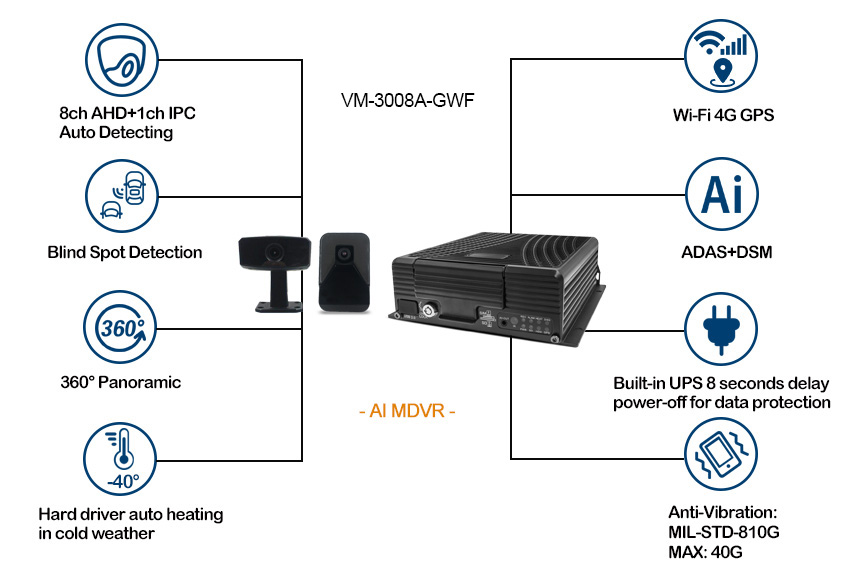Industry news
How to implement AI vehicle monitoring?
AI empowers in-vehicle monitoring, from "single video recording" to "functional integration"

In-vehicle video surveillance, as a sub-industry of the video surveillance industry, applies the video surveillance function of fixed places on the ground to moving vehicles, which is an important application of video surveillance in the field of transportation.
Compared with video surveillance in fixed places such as commerce, industry, community, home and safe city, in-vehicle video surveillance needs to be used in complex vehicle working environments (such as high-speed vehicle movement, continuous vibration and shock, high and low temperature, bad power supply, and human damage). , waterproof and fireproof, etc.), maintain good image processing and intelligent analysis performance, and have high technical requirements for products.
Vehicle-mounted video surveillance mainly serves all kinds of commercial vehicles in vehicle-mounted mobile scenarios, including buses, taxis, shuttle buses, chartered tours, hazardous chemicals transport vehicles, muck removal vehicles, sanitation vehicles, school buses, police vehicles and freight vehicles Wait.
Changes in market demand are driving the development of technology. Vehicle monitoring has evolved from a basic video recording function to integrated GPS/BD positioning, integrated 3G/4G transmission, and now integrated AI artificial intelligence function, which can analyze and warn driving behavior. .
Vehicle monitoring, from analog to digital to high-definition network, the technical principle includes network technology and image processing technology.
The actual situation is that most of the commercial vehicles with two passengers and one danger are not installed with intelligent video surveillance, but only installed with ordinary video surveillance equipment. There are still many challenges in the application of intelligent video surveillance.
The market demand is strong, why is it difficult to popularize?
With the vigorous development of the passenger and freight business of public transportation, the number of vehicles in the transportation market has increased year by year, but the corresponding traffic safety management has not kept up with the development of the situation. Driving behavior is the main cause of traffic accidents.
For this reason, the safety management of commercial vehicles in the operation process has received widespread attention from the public and high attention from regulatory authorities, and regulatory authorities and operating companies have an increasing demand for improving operational safety and management efficiency.
As an effective means to assist the safety supervision of commercial vehicles, the on-board monitoring system has also been widely optimistic about its market prospects and ushered in a period of stable growth.
At present, the market size of the global commercial vehicle video surveillance market is only about 12 billion yuan. According to the global 300 million commercial vehicles, the average price of a single vehicle product is 4,000 yuan, and the replacement cycle is 7-10 years. About 120-170 billion yuan, the industry is far from reaching the ceiling.
Compared with the huge number of commercial vehicles in the world, the current vehicle monitoring and even the intelligent vehicle monitoring market still has a huge market nugget space.
However, the current penetration rate of intelligent vehicle monitoring is still slightly insufficient, and ordinary video monitoring is mostly used on commercial vehicles.
There are mainly several reasons:
1. Passive acceptance: Some companies believe that in the vehicle monitoring market, driven by top-down policies, operating companies and drivers are mostly passively accepting, and they are prone to negative resistance to smarter video surveillance technology, which brings surveillance and uncontrolled issues.
Second, the actual effect is not as good as expected: the current vehicle monitoring only requires the installation of monitoring equipment, and does not pay much attention to the actual operation effect after the installation of the equipment, and this upward service model has not been implemented in the first-line management of the original operating enterprise.
3. High operation and management costs: Most of these intelligent video surveillance equipment are expensive, which is a large expenditure for the operation and management costs of enterprises. Therefore, even if there are policies to promote, enterprises will also control costs in order to , while using ordinary video surveillance equipment.
This also leads to the understanding of in-vehicle monitoring in the concept of some operating companies and drivers, more to monitor their driving behavior, rather than a tool to help them achieve safer driving control.
4. Insufficient knowledge of relevant technologies: Even if the operating company is equipped with intelligent on-board equipment, it is limited by factors such as the installation and use of "on-board monitoring + AI" products, and the lack of professional knowledge of relevant personnel. Without the support of professional talents and back-end platforms, it is difficult to play the role of front-end data in helping drivers’ driving behavior.
That is to say, under the top-down promotion mode, the deployment of on-board monitoring equipment not only increases operating costs for operating companies, but also helps the driving safety of operating vehicles, which does not achieve the original intention of its installation.
Iterative promotion of new technologies, changing "monitoring" to "service"
With the development of new-generation wireless communication technologies such as 5G networks, the network bandwidth will be wider, the network coverage will be more complete, and the unit traffic tariff will be lower, which will further promote the integration and development of vehicle-mounted monitoring products and new-generation wireless networks.
With the rapid development of big data cloud computing, the application of related technologies will effectively improve the operation efficiency of enterprises, reduce the operation cost of enterprises and improve the supervision efficiency of safety supervision departments.
For example, the current commercial vehicle network can technically provide basic vehicle operation data and real-time dynamic remote video monitoring in ensuring bus safety, which can completely reproduce the event process, intelligently analyze driving data, and achieve targeted and efficient management.
The current applications of AI technology in the automotive field are mainly intelligent image analysis technology and artificial intelligence deep learning technology. With the continuous progress of AI technology, the function of the video surveillance system has been shifted from post-tracing to pre-warning and in-process analysis to discover risks in real time and proactively.
The field of in-vehicle monitoring has developed from the management mode of vehicle management to "man-vehicle management". For example, the driving safety warning system can provide safety warnings for vehicles and people respectively; the vehicle-mounted video monitoring application platform, whose basic data can realize fleet, vehicle , line, site and other information management;
In addition, with the help of AI-enabled monitoring equipment, the driver's fatigue driving has become evidence-based. The new generation of driving early warning system, the image sensor of the camera can collect many data characteristics of the fatigue state of the face, extract and analyze, through advanced After the fatigue state algorithm is used to accurately judge, it will give voice and light prompts to warn the driver and correct wrong driving behavior.
Commercial vehicle safety is a complex system issue. No matter how good the equipment is, it cannot really play its role if it does not have a closed-loop management and control service of "smart equipment + intelligent risk control platform + risk control service" that combines front-end and back-end software and hardware.
In the era of big data, the installation of intelligent supervision equipment should not only meet the installation requirements, but also truly understand the service improvement brought by intelligent equipment to driving safety. The industry needs to change its cognition and be a service provider instead of a monitor.
At the same time, enterprises should also fully realize that the issue of security management is a complex and systematic issue. Equipment is only a data collection tool, and more needs to be combined with software and hardware, supplemented by powerful background services to build online and offline security. The closed-loop management service helps simplify vehicle management and truly curb risks.
Finally, supplemented by the necessary government safety supervision, guidance and promotion, a positive safety management improvement cycle is formed, and the enterprise safety management ability and technology application ability can be continuously improved to reduce the occurrence of tragedies.
Categories
Latest News
- important Notice2022-12-02
- National Day holiday notice2022-09-30
- Why do buses choose to install a p2022-08-05
- Do you know all the knowledge abou2022-08-05
- Vehicle camera technology trends2022-07-29
Contact Us
Contact: Judy
Phone: 8613632508437
Tel: 0755-23708912
Add: 2/F, B1# Building, Baifuli Industrial Park, Longhua District, Shenzhen, China

 Judy
Judy visionmaster
visionmaster